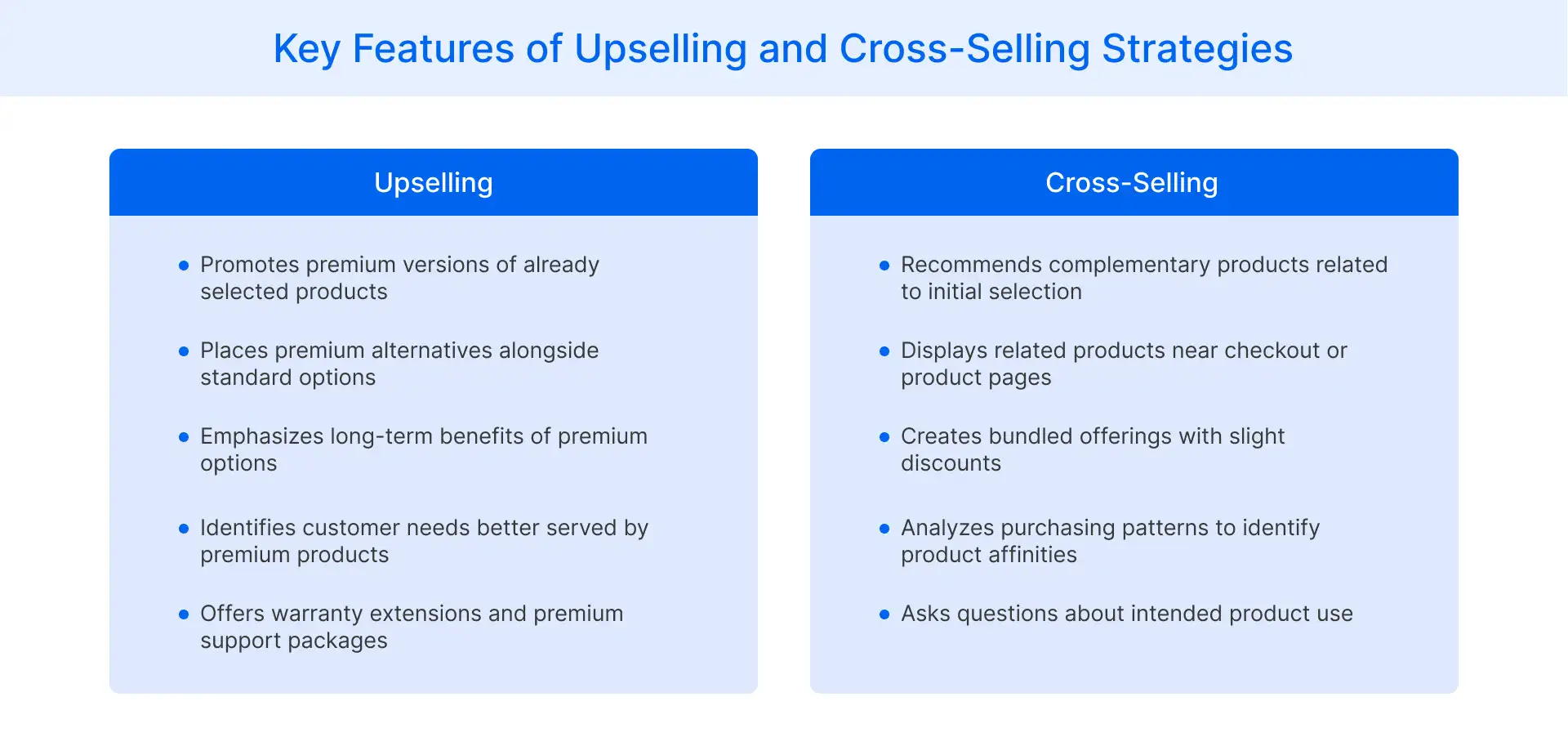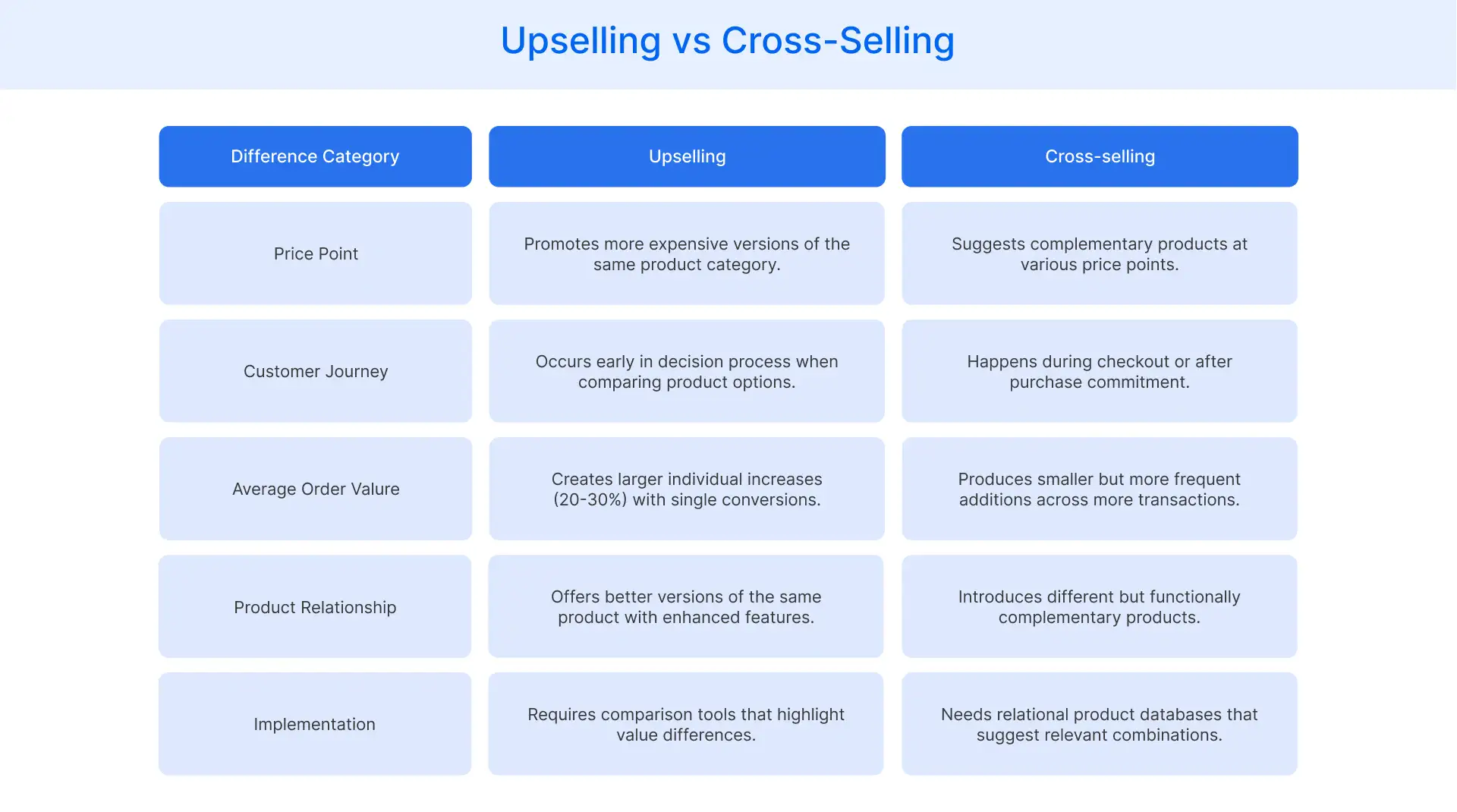Table of Contents
- What is the Difference Between Upselling and Cross-Selling in Retail?
- What is Upselling in Retail?
- What is Cross-Selling in Retail?
- How Do Cross-Selling and Upselling Differ?
- How Does Flipkart Commerce Cloud Help Retailers With Smart Upselling and Cross-Selling Strategies
What is the difference between Upselling and Cross-Selling in Retail?
In retail, upselling and cross-selling serve as powerful tools to increase the total value of a customer’s purchase and boost your bottom line. While both aim to boost revenue, they work in different ways and represent distinct sales tactics.
Upselling involves encouraging customers to consider an advanced, feature-rich, or more expensive product than the item they are already interested in. Cross-selling, on the other hand, suggests related items that complement the main product, often positioning it as a bundled purchase.
Retailers use these techniques to improve the customer experience, add perceived value, and increase the average order value. These techniques are commonly integrated into both online and in-store journeys, such as personalized product recommendations, checkout process prompts, or suggestions from a trained sales team.
When done right, with the right timing and a helpful approach, upselling and cross-selling not only raise the average order value but also help address customers’ needs more comprehensively, leading to customer loyalty and repeat purchases.
What is Upselling in Retail?
Upselling is a sales technique where retailers encourage customers to purchase a version of a product that is more expensive or upgraded from their initially selected product. This strategy focuses on increasing the value of a single transaction by highlighting the enhanced benefits and advanced features of premium alternatives.
You can implement upselling at various touchpoints throughout the customer journey to maximize transaction values. Here are the key differences and aspects of this marketing strategy:
- Strategic product placement creates natural upselling opportunities, especially when premium alternatives sit alongside standard options with clear comparison points.
- Emphasize long-term benefits and enhanced value of premium options rather than drawing attention solely to the higher cost points.
- Consider post-purchase opportunities through warranty extensions, service plans, or premium support packages that enhance the original product experience.
- Leverage customer feedback on digital marketplace platforms to personalize upselling recommendations based on browsing patterns, stated preferences, and previous purchases.
What is an Example of Upselling?
A common upselling example occurs in electronics retail when a customer browses basic smartphone models. You can present a comparison showing how the premium model offers double the storage capacity, enhanced camera features, and longer battery life.
The customer initially planned to spend $699, but your strategic upselling helps them recognize the value in upgrading to the $899 model. This benefits both parties as the customer receives a better-suited product for their needs, while you increase your average transaction value by $200.

What is Cross-Selling in Retail?
Cross-selling is a sales technique that involves recommending complementary or related products to customers based on their initial purchase intent. Unlike upselling, which focuses on upgrading the same product, cross-selling expands the purchase horizontally with additional items that enhance or complement the original selection.
You can implement this strategy to increase average order value while providing current customers with a more complete solution. Here are the key aspects of this retail strategy:
- Display related products strategically near checkout points or in the shopping cart to naturally suggest combinations that work well together..
- Analyze purchasing patterns to identify product affinities, revealing which items are frequently bought together and informing smarter cross-selling suggestions.
- Create bundled offerings that combine complementary products at a slight discount, encouraging customers to purchase multiple items simultaneously.
- Train staff to ask relevant questions about how customers plan to use their purchases, opening natural conversations about complementary products.
- Implement post-purchase cross-selling through email marketing showcasing accessories or supplies that enhance the value of recently purchased items.
What is an Example of Cross-Selling?
A practical cross-selling example occurs when a furniture retailer suggests complementary items after a customer selects a dining table. Presenting matching chairs, table linens, centerpiece accessories, and care products creates a complete dining experience.
The customer came with a $1,200 budget for just the table, but leaves spending $2,100 on a coordinated set. This approach satisfies the customer’s previously unrecognized needs while significantly increasing the average order value.
The fashion industry provides another excellent example, where a dress purchase can lead to suggestions for matching accessories, shoes, and jewelry, effectively showcasing how ecommerce shines at presenting visually appealing combinations.
How Do Cross-Selling and Upselling Differ?
While both strategies boost revenue, upselling and cross-selling take different approaches to increasing revenue and enhancing customer relationships.
Price Point Differences
Upselling guides customers toward more expensive versions of their chosen product, like suggesting a premium blender instead of the basic model. Cross-selling recommends additional products at various prices, such as blender accessories, recipe books, or warranty plans that complement their original choice.
Customer Journey Placement
Place upselling offers early when customers are still deciding which product to buy and comparing features. Save cross-selling for later stages such as during checkout, immediately after purchase, or in follow-up emails when new customers have already made their main purchase.
Impact on Average Order Value
Successful upselling significantly increases transaction value with a single upgrade, often boosting the purchase amount by 20-30%. Cross-selling typically involves adding smaller amounts but occurs more frequently, resulting in steady revenue increases across a greater number of customer interaction points.
Product Relationship Variations
Upselling involves offering better versions of the same product, such as a coffee maker with additional features or higher-quality materials. Cross-selling introduces different but related products that work with the original purchase, such as coffee beans, filters, or cleaning supplies.
Implementation Complexity
Setting up upselling requires good product comparison tools that clearly show why premium options offer a better experience. Cross-selling needs a smart system that connects related products and makes relevant suggestions without overwhelming the customer with too many options from your entire product range.

How does Flipkart Commerce Cloud Help Retailers With Smart Upselling and Cross-Selling Strategies?
At Flipkart Commerce Cloud (FCC), we empower retailers to implement effective upselling and cross-selling strategies through our comprehensive suite of retail technology solutions that help in building trust with your customer base.
Our Digital Commerce Solution creates personalized shopping experiences that naturally guide customers toward premium alternatives and complementary products. The platform analyzes customer behavior patterns and purchase history to identify the most promising opportunities for upselling and cross-selling at each stage of the shopping journey.
Our AI-driven Retail Media Platform enhances cross-selling capabilities by displaying highly relevant product recommendations based on real-time shopper intent and behavior. This sophisticated system understands the entire customer journey, placing personalized product suggestions that complement items in the cart or recently viewed products.
Our Pricing Manager uses machine learning models to analyze price elasticity and historical sales data, helping you implement dynamic pricing strategies that optimize margin potential for upsell offers. By integrating these powerful tools, we ensure your upselling and cross-selling strategies work seamlessly together to maximize both customer satisfaction and business profitability.
FAQ
Online stores benefit from automated recommendation engines, product comparison tools, and post-purchase email sequences for extended selling opportunities. Physical stores rely on staff training, strategic product placement, and tactile demonstrations that showcase how products work together to create complete solutions.
These strategies leverage reciprocity by providing customers with personalized recommendations and making them feel valued. Social proof is adequate when you highlight popular upgrades or frequently purchased combinations. Loss aversion engages customers when you emphasize benefits, they might miss without premium features or complementary products.
Overuse of upselling and cross-selling can overwhelm customers, leading to frustration or abandoned carts. If recommendations feel pushy or irrelevant, shoppers may distrust the brand, which can impact long-term loyalty and overall customer satisfaction.
Retailers can evaluate performance by tracking attachment rates, order value increases, and conversion improvements. Additionally, A/B testing various placements, analyzing product pairings, and comparing incremental revenue against implementation costs can also help determine the return on investment.

